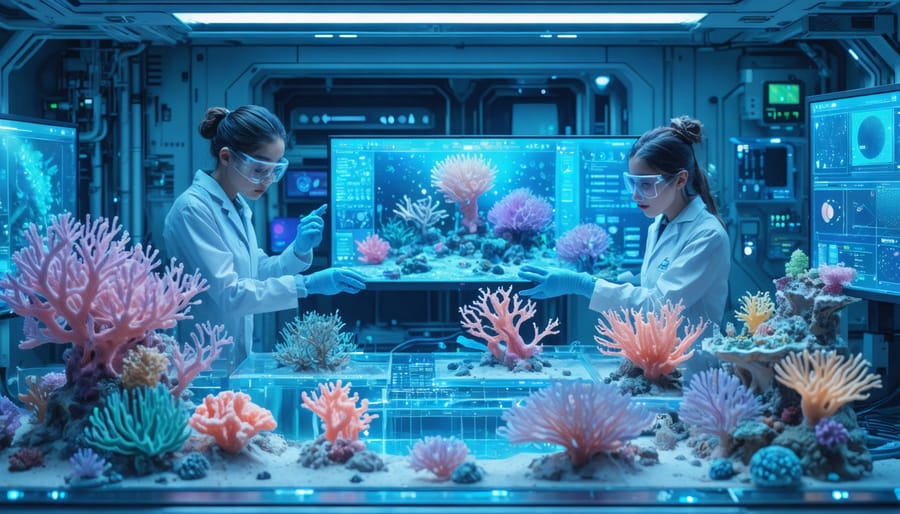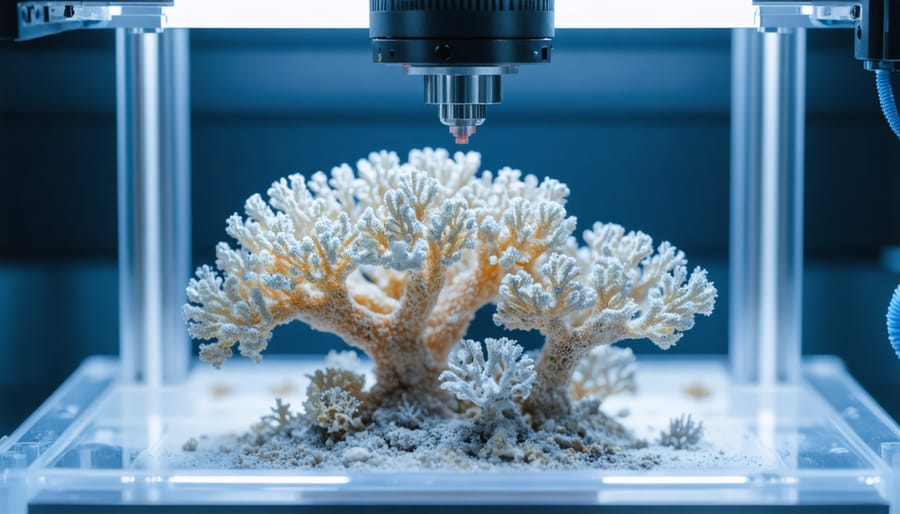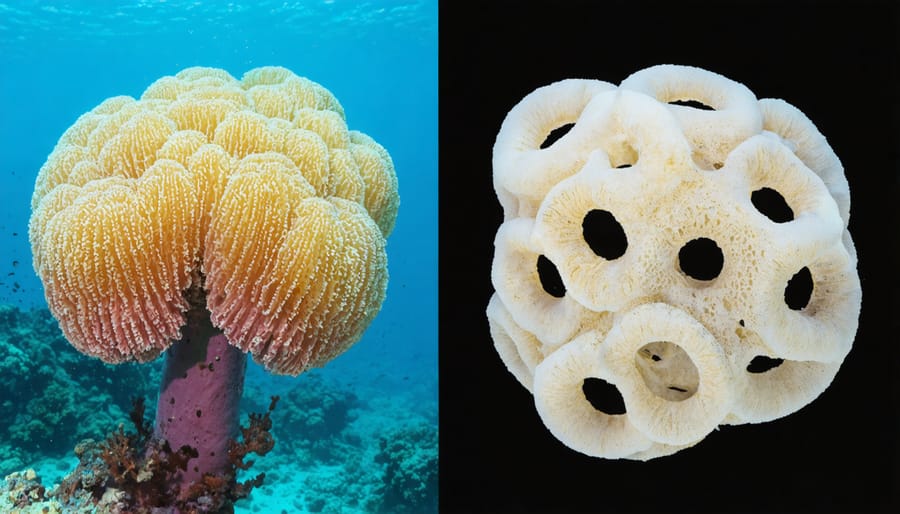
Beneath the ocean’s surface, reef-building corals orchestrate one of nature’s most remarkable engineering feats, creating vast underwater cities that support 25% of all marine life. These tiny polyps, working in harmony over centuries, not only construct the largest living structures on Earth but also form the foundation of marine ecosystems worth over $375 billion annually in ecosystem services. Yet today, as climate change and ocean acidification threaten these ancient architects, innovative approaches to marine habitat restoration are emerging at the intersection of biology and technology. By combining traditional conservation methods with cutting-edge bioengineering techniques, scientists are pioneering new ways to preserve and rebuild these crucial marine ecosystems. From 3D-printed reef structures to resilient coral breeding programs, the race to protect these underwater builders represents one of the most urgent and inspiring challenges in marine conservation. Their survival isn’t just about preserving biodiversity – it’s about securing the future of our oceans and the communities that depend on them.
Understanding Reef-Building Corals
The Architecture of Natural Coral Growth
Coral reefs grow through a remarkable natural engineering process that has evolved over millions of years. Individual coral polyps secrete calcium carbonate to form their protective skeletal structures, gradually building upon previous generations to create massive reef formations. This process begins when free-swimming coral larvae, called planulae, attach themselves to hard surfaces on the seafloor.
As the polyps mature, they extract calcium and carbonate ions from seawater to construct their limestone skeletons. This biomineralization process occurs primarily at night, with polyps depositing new skeletal material in thin layers. During the day, the symbiotic zooxanthellae within the coral tissue photosynthesize, providing essential nutrients that fuel the coral’s growth.
The architecture of coral reefs develops in distinct patterns influenced by environmental factors such as water movement, light availability, and temperature. Branching corals grow upward and outward, creating complex three-dimensional structures that provide habitat for countless marine species. Massive corals form dome-like structures that contribute to the reef’s foundation, while encrusting corals spread across surfaces, strengthening the reef framework.
This natural construction process typically progresses at rates of 0.3 to 2 centimeters per year, demonstrating the patience required for reef development.

Critical Environmental Factors
Reef-building corals require specific environmental conditions to thrive and construct their magnificent underwater structures. Water temperature plays a crucial role, with most species preferring temperatures between 23-29°C (73-84°F). Sudden temperature changes, particularly warming events, can trigger coral bleaching and potentially lead to widespread death within reef communities.
Light availability is equally essential, as the symbiotic zooxanthellae algae living within coral tissues need sunlight for photosynthesis. This explains why most reef-building corals are found in clear, shallow waters where sunlight can penetrate effectively. Water clarity and quality are vital factors, with corals requiring clean, nutrient-balanced water with stable salinity levels around 35 parts per thousand.
The pH level of seawater significantly impacts coral growth, with most species thriving in slightly alkaline conditions (pH 8.2-8.4). Ocean acidification, caused by increasing atmospheric CO2 levels, poses a serious threat to coral reef ecosystems by making it harder for corals to build their calcium carbonate skeletons.
Water movement is another critical factor, as currents help deliver nutrients and oxygen while removing waste products and sediment. Additionally, moderate water flow supports coral reproduction and larval dispersal throughout reef systems.
Advanced Biofabrication Techniques
3D Bioprinting Technology
3D bioprinting technology has emerged as a groundbreaking solution for coral reef restoration, offering new hope for endangered reef ecosystems. This innovative approach involves creating artificial coral scaffolds that closely mimic the complex architectural structures of natural coral colonies.
The process begins with detailed 3D scanning of existing coral formations to capture their intricate designs. Using specialized bioprinting equipment, scientists then construct calcium carbonate-based scaffolds layer by layer, ensuring the structures provide optimal conditions for coral polyp attachment and growth.
These artificial scaffolds are designed with specific features that promote coral settlement, including textured surfaces and internal channels that facilitate water flow and nutrient distribution. The materials used are carefully selected to be biocompatible and environmentally safe, often incorporating natural coral skeleton components to enhance integration with existing reef systems.
Recent advances in bioprinting technology have enabled researchers to incorporate living coral cells directly into the printing process. This technique, known as coral tissue printing, combines coral fragments with a biocompatible gel that can be precisely deposited onto the scaffolds. The resulting structures provide an ideal environment for coral growth while maintaining the genetic diversity of natural reef populations.
Marine biologists have reported encouraging results from field trials, with printed coral structures showing successful integration into existing reef systems and supporting new coral growth within months of deployment.

Cellular Engineering
In laboratories worldwide, scientists are making remarkable progress in growing coral tissue under controlled conditions, offering hope for reef restoration. The process begins with isolating coral cells from small tissue samples, which are then cultured in specialized growth media containing essential nutrients and minerals that mimic the ocean environment.
Researchers have developed innovative techniques to encourage coral cell proliferation, including the use of specialized bioreactors that maintain optimal temperature, pH, and oxygen levels. These systems often incorporate LED lighting that simulates natural sunlight patterns, crucial for the photosynthetic algae (zooxanthellae) that live symbiotically within coral cells.
One breakthrough approach involves creating “coral microfragments,” where small pieces of coral tissue are grown on artificial substrates. These fragments can develop into fully functional coral polyps under laboratory conditions, significantly accelerating growth rates compared to natural reef environments.
Scientists are also exploring genetic techniques to enhance coral resilience. By studying cells from heat-resistant coral colonies, researchers can identify and potentially cultivate strains better suited to warming ocean conditions. This work often involves collaboration between marine biologists and cellular engineering specialists, combining expertise to develop more effective cultivation methods.
The knowledge gained from cellular engineering has practical applications in coral nurseries and restoration projects, where laboratory-grown corals can be transplanted to damaged reef areas, offering new hope for reef recovery efforts.
Biomaterial Innovation
Recent advances in biomaterial science have revolutionized coral reef restoration efforts, introducing innovative solutions for rebuilding damaged reef systems. Scientists have developed several eco-friendly materials that serve as artificial substrates for coral growth while minimizing environmental impact.
Calcium carbonate-based materials, mimicking natural reef structures, have shown particular promise. These substrates are created using 3D printing technology, allowing researchers to design complex structures that optimize water flow and coral attachment. The materials are carefully engineered to maintain the precise pH levels necessary for coral growth while providing the structural integrity needed to withstand ocean currents.
Biodegradable polymers have emerged as another groundbreaking solution. These materials gradually decompose as coral colonies establish themselves, leaving behind only the natural reef structure. Some innovative designs incorporate beneficial minerals and compounds that slowly release into the surrounding water, promoting coral growth and resilience.
Marine-grade ceramics have also proven effective, offering excellent surface characteristics for coral larvae settlement. These materials are treated with specific surface textures and chemical compositions that encourage the attachment and growth of coral polyps.
The success of these biomaterials has inspired a new wave of restoration projects worldwide, with many incorporating local materials and traditional knowledge into their design. This fusion of modern technology with ecological understanding is creating more sustainable and effective solutions for coral reef conservation.
From Lab to Ocean
Transportation and Deployment
The successful deployment of artificial reef structures requires careful planning and specialized equipment to minimize environmental impact while rebuilding marine ecosystems. Transportation typically involves vessels equipped with cranes and stabilizing systems to prevent damage during transit. Marine biologists and engineering teams work together to identify optimal deployment locations using detailed seafloor mapping and current analysis.
Before transportation, artificial reef structures are thoroughly cleaned and prepared to prevent the introduction of invasive species or contaminants. They are then carefully loaded onto specially designed barges or vessels using cushioning materials to protect both the structures and the vessel.
During deployment, GPS positioning ensures precise placement, while experienced dive teams guide the structures into position using lift bags and underwater communication systems. Weather conditions and tidal patterns are carefully monitored to select the ideal deployment window, reducing risks to both the installation team and the structures.
Modern deployment methods often incorporate innovative techniques such as floating frames and guide wires to maintain control during descent. Some projects utilize modular designs that can be assembled underwater, making transportation more manageable and reducing the risk of damage during installation.
Community involvement plays a crucial role, with local diving groups and marine conservation organizations often participating in deployment operations, creating opportunities for hands-on education and fostering environmental stewardship.

Monitoring and Success Metrics
Scientists employ various sophisticated methods to track the success of biofabricated coral implementations. Using underwater photography and videography, researchers document changes in coral growth, coverage, and overall reef health through time-lapse monitoring. Advanced 3D mapping technology creates detailed models of reef structures, allowing precise measurements of coral expansion and structural complexity.
Regular biodiversity surveys assess the presence and abundance of fish species, invertebrates, and other marine organisms that indicate a healthy reef ecosystem. Researchers collect data on coral survival rates, growth patterns, and reproduction success through systematic observation and measurement protocols. Water quality parameters, including temperature, pH levels, and nutrient concentrations, are continuously monitored using automated sensors and regular sampling.
Genetic analysis helps track the diversity and resilience of coral populations, while tissue sampling provides insights into the coral’s physiological health and symbiotic relationships. Citizen science programs engage local communities and diving enthusiasts in monitoring efforts, expanding data collection capacity while fostering environmental awareness.
Success metrics typically include:
– Coral survival rate (%)
– Growth rate (cm/year)
– Reef fish population diversity
– Calcium carbonate accretion rates
– Reproductive output
– Ecosystem service indicators
– Community engagement levels
These comprehensive monitoring approaches help scientists adjust restoration strategies and ensure the long-term success of coral reef rehabilitation efforts, while providing valuable data for future conservation initiatives.
Future Prospects and Challenges
The future of reef-building corals stands at a critical intersection of technological innovation and environmental challenges. Recent advances in coral biofabrication, combined with the development of sustainable reef materials, offer promising solutions for reef restoration. Scientists are exploring groundbreaking techniques such as 3D printing of coral structures using calcium carbonate-based materials that closely mimic natural reef formations.
Artificial intelligence and machine learning are revolutionizing our approach to coral restoration. These technologies help predict bleaching events, optimize growth conditions, and identify the most resilient coral species for cultivation. Researchers are also developing automated systems for coral fragment propagation, potentially scaling up restoration efforts significantly.
However, significant challenges remain. Ocean acidification and rising sea temperatures continue to threaten coral survival, making it crucial to develop heat-resistant coral strains. The cost of large-scale biofabrication remains prohibitive, and there’s an ongoing need for more efficient, cost-effective methods.
Another pressing challenge is the integration of artificial reef structures with natural ecosystems. Scientists must ensure that engineered solutions support, rather than disrupt, existing marine communities. This includes considering factors such as water flow patterns, species interactions, and long-term ecosystem stability.
Looking ahead, emerging technologies like CRISPR gene editing show potential for enhancing coral resilience. Researchers are also exploring the use of probiotics and beneficial microorganisms to boost coral immune systems. These innovations, combined with traditional conservation methods, could provide a comprehensive approach to reef preservation.
Community involvement remains crucial for success. Citizen science programs and local restoration initiatives are becoming increasingly important, creating opportunities for public participation in coral conservation efforts. This collaborative approach, uniting scientific innovation with community action, represents our best hope for preserving these vital marine ecosystems for future generations.
The convergence of biofabrication technologies and coral conservation offers a promising path forward in our fight to preserve these vital marine ecosystems. Through innovative approaches like 3D bioprinting, selective breeding, and coral gardening, scientists are developing powerful tools to combat the devastating effects of climate change on reef-building corals.
However, the success of these conservation efforts depends on more than just scientific advancement. It requires a collective commitment from communities, governments, and individuals worldwide. You can support coral conservation by making climate-conscious choices in your daily life, such as reducing your carbon footprint and choosing reef-safe sunscreens. Consider volunteering with local marine conservation organizations or participating in citizen science projects that monitor coral health.
Many organizations offer opportunities to “adopt” a coral or contribute to restoration projects. Educational institutions and research centers welcome public participation in their coral nursery programs, where you can learn hands-on techniques for coral propagation and restoration.
By staying informed about coral conservation efforts and sharing this knowledge with others, you become part of the solution. While the challenges facing coral reefs are significant, the combination of innovative biofabrication techniques and community engagement provides hope for their future. Together, we can help ensure these magnificent ecosystems continue to thrive for generations to come.
Remember, every action counts in the preservation of coral reefs, whether it’s supporting research initiatives, participating in local conservation efforts, or making environmentally conscious decisions in your daily life.
jessica
Ava Singh is an environmental writer and marine sustainability advocate with a deep commitment to protecting the world's oceans and coastal communities. With a background in environmental policy and a passion for storytelling, Ava brings complex topics to life through clear, engaging content that educates and empowers readers. At the Marine Biodiversity & Sustainability Learning Center, Ava focuses on sharing impactful stories about community engagement, policy innovations, and conservation strategies. Her writing bridges the gap between science and the public, encouraging people to take part in preserving marine biodiversity. When she’s not writing, Ava collaborates with local initiatives to promote eco-conscious living and sustainable development, ensuring her work makes a difference both on the page and in the real world.
